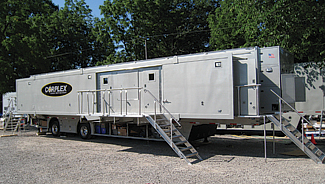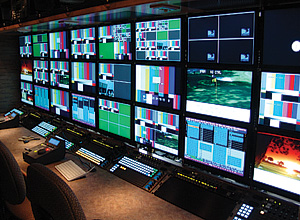Sports Production Trucks Rein in Costs
LOS ANGELES
Broadcasters are walking a high wire act, simultaneously trying to balance the need to accommodate HD's greater storage and transferability requirements with mandates to cut costs. The quest is further complicated for those charged with remote sports production due to space constraints and the high cost of fuel. In short, this year it's all about saving money through judicious choices.
For example, upgrades to FoxSports' FXB truck, contracted from Game Creek Video for NFL games, were limited to three items, according to Jerry Steinberg, the network's senior vice president of operations.
"They put in a Calrec audio board and they upgraded the EVS's to XT2s and they changed the monitor walls to flat screen," he said.
STORAGE
EVS XT2 technology—preferably with Gigabit Ethernet—seemed to top everyone's list of must-haves; flat screen monitor walls ran a close second.

CBS deployed Corplex's new Iridium expando to cover last month's PGA Championship in Bloomfield Township, Mich. The good news is that EVS XT2 hardware with Version 9 software and Gigabit Ethernet options are available this year. The bad news is that the upgrade is expensive and piecemeal transition isn't much of an option because of legacy issues.
EVS XT2s have more storage capacity and greater throughput. XT2s plus Version 9 software enable direct transfer to Avid edit systems via Avid's DNxHD codec, a means to pave the way for a more tapeless operation. Adding GigE enables a second EVS network to further improve traffic flow.
An upgrade encompassing all three factors made a big difference in capturing the 2008 Summer X Games, according to Stephen Raymond, coordinating technical manager for ESPN.
"The upgrades were made to all the EVS XT2 servers and included both maximum hard drive size allowed on the platform [5/300 GB per] and the Gigabit Ethernet NICs," said Raymond. "This was the most significant change from prior X Games. It was done to accommodate the increased storage and heavy, large file transfer needs of the network associated with HD workflows, [which] were problematic at the last HD X Games event."
Turner Sports decided to swap last year's mixed network of XT and XT2 devices in NEP's SS-24 truck for an all XT2 system last spring.
"The XT2s have a much faster networking format so we're able to exchange clips between the channels five times faster than before—the complaints dropped considerably," said Tom Sahara, senior director, IT and remote operations for Turner Sports. Prior to the switch "we had to be very careful in how we mapped out the systems—how we laid out which machines did what function to minimize the clip transfers—so that we wouldn't get bottlenecks as they traded clips."
But the EVS upgrade is expensive.
"The average HD mobile unit for CBS football and basketball, excluding the 'big boys,' costs about $8 million to build," said John McCrae, director of field operations for CBS Sports. "Of that, over $1 million is for the EVS devices. You can double all of that for the 'big boys.'"
And, as noted, piecemeal upgrades are problematic. So, both truck providers and their customers are trying their best to bite the bullet.

A flat screen monitor wall, like this one in Corplex's new Iridium HD production truck, is a top priority for today's remote production studios."NEP has a major initiative to upgrade our EVS complement to XT2s," said George Hoover, CTO for NEP Broadcasting. "In fact, we have purchased nearly 50 EVS XT2s in the last 12 months."
MONITOR WALLS & FIBER
In addition to looking good, flat screen monitor walls provide economic benefits.
"The flat screens are preferred because of weight and power savings on the trucks," said Turner Sports' Sahara. "What removing the weight and power does is allows us to put more equipment in the truck. Or it allows us to run the truck without having to use additional B units."
Sahara would also like truck providers to offer fiber-optic equipment needed for HD signals.
"If that became part of the truck complement, that would be a benefit, because I wouldn't have to ship it in," he said. "It would save me the shipping and the headache of having to outsource it from someone else."
CBS Sports' Director of Engineering Bruce Goldfeder is looking for "more integration of video over IP technology and more bandwidth to the mobile units." Other decisionmakers at CBS Sports are looking for cheaper HD trucks, particularly for its college network cable entities.
"No one has yet defined what that 'cheap HD truck' is," said McRae. And even when that happens, he said, "It will take multi-year, multi-event commitments from the little guys to get these built."
This view was upheld by NEP's Hoover.
"Less expensive is as much a function of smaller and how it is equipped as it is how often it is used," said Hoover. "Our industry is searching for a smaller platform with a common equipment package that will be acceptable to and used by a number of our clients. A nice relatively small and less expensive truck can be built, but if it is acceptable to only one client who wants to drive it all over the country and use it only 10 to 12 time a year, then in the long run it won't be less expensive to that client. On the other hand, if it has universal appeal and can be put to work for 100 to 150 events a year in a regional area, it will be less expensive."
Get the TV Tech Newsletter
The professional video industry's #1 source for news, trends and product and tech information. Sign up below.
